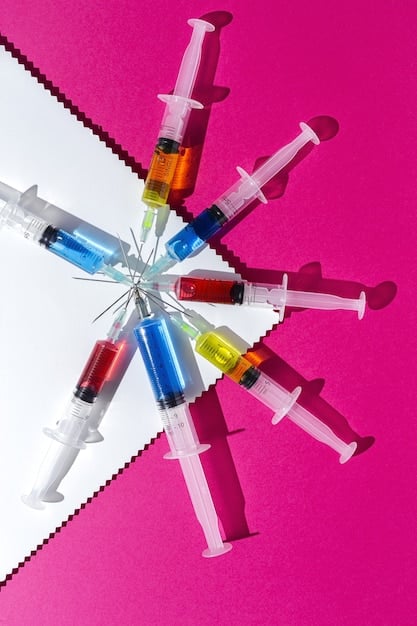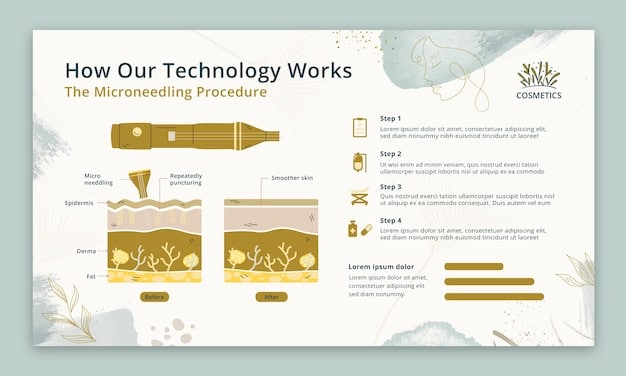Hyaluronic Acid Fillers: The Ultimate Guide to Types & Benefits

Hyaluronic acid fillers are cosmetic injectables used to reduce wrinkles, enhance facial contours, and restore volume, offering various types tailored to specific aesthetic goals and lasting from several months to over a year.
Are you considering facial fillers to rejuvenate your appearance? Understanding the nuances of hyaluronic acid fillers and their benefits is key to making informed decisions. This guide explores the variety of hyaluronic acid fillers available, helping you choose the best option for your aesthetic goals.
Understanding hyaluronic acid fillers: What are they?
Hyaluronic acid fillers have revolutionized the field of cosmetic enhancements. But what exactly are they? Essentially, they are injectable treatments used to restore volume, smooth fine lines, and enhance facial contours. Understanding the basics helps in appreciating their widespread use and versatility.
The science behind hyaluronic acid
Hyaluronic acid (HA) is a naturally occurring substance in the body, found in high concentrations in the skin, eyes, and connective tissues. It acts as a humectant, meaning it attracts and retains moisture, which keeps tissues hydrated and plump.
- Natural Hydration: HA’s primary role is to maintain hydration levels in the skin, reducing the appearance of dryness and aging.
- Volume Restoration: As we age, our natural HA levels decrease, leading to volume loss. HA fillers replenish this loss, restoring a youthful fullness.
- Skin Elasticity: HA supports collagen and elastin production, crucial proteins for maintaining skin elasticity and firmness.
How hyaluronic acid fillers work
Hyaluronic acid fillers are made from a synthetic form of HA that mimics the body’s natural HA. When injected, they immediately add volume to the treatment area; over time, they also stimulate collagen production, further enhancing skin texture and firmness.
The effects of HA fillers are temporary, as the body gradually metabolizes the injected HA. Depending on the type of filler and individual factors, results typically last from six months to two years, making it a flexible option for aesthetic enhancements.
Hyaluronic acid fillers offer a fantastic solution for anyone looking to rejuvenate their appearance and enhance their natural beauty. Their ability to hydrate, add volume, and stimulate collagen production makes them a cornerstone of modern cosmetic treatments. By understanding how these fillers work, you can make informed decisions about achieving your aesthetic goals.
Different types of hyaluronic acid fillers available
The world of hyaluronic acid fillers is diverse, offering a variety of formulations tailored to address specific aesthetic concerns. Each type of filler has unique properties, such as varying thicknesses and densities, which determine its suitability for different areas of the face.

Understanding filler consistency and density
The consistency and density of a hyaluronic acid filler are crucial factors that dictate its use. Thicker, denser fillers are ideal for adding volume and structure to areas like the cheeks and jawline, while thinner, more flexible fillers are better suited for smoothing fine lines and wrinkles in delicate areas like the lips and under-eyes.
Particle size also plays a significant role. Fillers with smaller particles tend to provide a smoother, more natural-looking result in areas where precision is key. Your practitioner will choose a filler based on the desired effect and the specific characteristics of your skin.
Popular brands and their uses
Several well-known brands offer a range of hyaluronic acid fillers, each designed for a particular purpose:
- Juvederm: Known for its smooth consistency, Juvederm fillers are versatile and effective for treating wrinkles, enhancing lips, and adding volume to cheeks. Juvederm Voluma is specifically designed for cheek augmentation, providing lift and contour.
- Restylane: Restylane fillers offer a more granular texture, making them excellent for addressing fine lines and wrinkles while maintaining a natural look. Restylane Lyft is formulated for deeper injections to correct volume loss in the cheeks and hands.
- Belotero: Belotero fillers integrate seamlessly into the skin, making them ideal for treating superficial lines like those around the mouth and eyes. They are less likely to cause the Tyndall effect (a bluish discoloration) when used in delicate areas.
Selecting the correct type of hyaluronic acid filler is essential for achieving optimal results. By understanding the differences in consistency, density, and brand-specific formulations, you can work with your cosmetic provider to choose the filler that best meets your individual needs and aesthetic goals.
Benefits of choosing hyaluronic acid fillers
Opting for hyaluronic acid fillers comes with a range of compelling benefits, making them a popular choice for cosmetic enhancements. From immediate visible improvements to long-term skincare advantages, the advantages are diverse and appealing.
Immediate results and natural look
One of the most significant advantages of hyaluronic acid fillers is the immediacy of the results. Patients often notice a visible improvement right after the treatment, with lines softened and volume restored. HA fillers also enhance natural features without looking artificial.
The hyaluronic acid used in these fillers mimics the body’s own HA, allowing the skin to accept the treatment more readily. This compatibility ensures that the enhanced features blend seamlessly with the existing facial structure, therefore, providing a subtle yet significant transformation.
Minimal downtime and reversible effects
Compared to surgical procedures, hyaluronic acid fillers require minimal downtime. Most patients can return to their daily activities soon after the treatment, with only minor swelling or redness that typically subsides within a few days.
The benefits of using hyaluronic acid fillers include:
- Quick Recovery: Minimal downtime allows for a swift return to normal activities.
- Lower Risk: Non-surgical, minimally invasive treatments involve fewer risks compared to surgery.
- Natural Adjustment: Effects smooth with time, maintaining a subtle, unaltered appearance.
Another advantage is the reversibility of HA fillers. If a patient is unsatisfied with the results or experiences complications, an enzyme called hyaluronidase can be injected to dissolve the filler. This option provides reassurance for those new to cosmetic procedures.
Overall, hyaluronic acid fillers provide an excellent combination of immediate aesthetic improvements, minimal downtime, and reversibility. Their ability to deliver natural-looking results while enhancing skin hydration and elasticity makes them a perfect option for anyone seeking a refreshed and youthful appearance.
How to prepare for your hyaluronic acid filler treatment
Preparing properly for your hyaluronic acid filler treatment can significantly enhance your results and reduce the risk of complications. Thoughtful pre-treatment care ensures that your skin is in optimal condition for the procedure.

Consultation and medical history
The first step in preparing for HA filler treatment is a thorough consultation with a qualified practitioner. This discussion should cover your aesthetic goals, medical history, and any current medications or supplements you are taking.
Providing a complete medical history helps your practitioner assess whether you are a suitable candidate for fillers and identify any potential risk factors. Sharing your expectations ensures that the practitioner can recommend the most appropriate treatment plan to achieve your desired outcome.
Pre-treatment precautions
To minimize the risk of bruising and swelling, there are several precautions you should take in the days leading up to your appointment:
- Avoid Blood Thinners: Refrain from taking blood-thinning medications such as aspirin, ibuprofen, and naproxen, unless prescribed by a doctor.
- Skip Supplements: Discontinue the use of supplements like vitamin E, ginkgo biloba, and fish oil, as they can also increase the risk of bruising.
- Limit Alcohol: Alcohol thins the blood and can increase swelling and bruising. Avoid alcohol consumption for at least 24 hours before the treatment.
Staying hydrated and maintaining a healthy diet can also improve your skin’s overall condition and reduce the likelihood of complications. Following these steps ensures that you and your skin are well-prepared for the hyaluronic acid filler treatment, helping you get the best possible results.
What to expect during the procedure
Knowing what to expect during the hyaluronic acid filler procedure can help alleviate any anxiety and ensure a smooth, comfortable experience. Understanding each step, from preparation to injection, puts you at ease and sets the stage for great results.
Step-by-step process
The hyaluronic acid filler procedure typically follows several key steps:
- Cleansing: The treatment area is thoroughly cleansed to remove any makeup, oil, and debris. This step reduces the risk of infection.
- Anesthesia: A topical anesthetic or ice pack may be applied to numb the area and minimize discomfort during the injections. Some fillers also contain lidocaine, a local anesthetic, for added comfort.
- Injection: The hyaluronic acid filler is carefully injected into the targeted areas using a fine needle or cannula. The practitioner may use different injection techniques to achieve the desired volume and contour.
Pain management and discomfort
Most patients report minimal discomfort during the procedure. Numbing agents like topical creams and lidocaine-infused fillers significantly reduce pain. The practitioner may also use techniques like distraction or gentle pressure to further ease any discomfort.
The duration of the procedure varies depending on the area being treated and the amount of filler used. Generally, a session can take anywhere from 15 minutes to an hour. This quick turnaround makes it easy to fit the treatment into a busy schedule.
Understanding the step-by-step process and available pain management techniques can make your hyaluronic acid filler experience much more pleasant. You will feel confident and relaxed, knowing exactly what to expect, setting you up for satisfying results.
Aftercare and how to maintain your results
Proper aftercare is essential for achieving the best possible results from your hyaluronic acid filler treatment and prolonging their effects. Taking care of your skin post-procedure helps prevent complications and maintains your youthful appearance.
Immediate aftercare tips
Immediately following your treatment, there are several steps you can take to ensure optimal healing and results:
- Apply Ice: Use an ice pack to reduce swelling and bruising. Apply ice for 10-15 minutes at a time, several times a day, for the first 24-48 hours.
- Avoid Strenuous Activity: Refrain from intense exercise and activities that could increase blood flow to the face for at least 24 hours.
- Stay Hydrated: Drink plenty of water to keep your skin hydrated, which supports the effects of the hyaluronic acid.
Long-term maintenance strategies
To maximize the longevity of your hyaluronic acid filler results, consider adopting the following long-term strategies:
- Sun Protection: Protect your skin from sun exposure by wearing sunscreen with at least SPF 30 daily. Sun damage can break down collagen and elastin, diminishing the effects of the filler.
- Healthy Lifestyle: Maintain a balanced diet, get enough sleep, and avoid smoking. These habits promote overall skin health and can extend the life of your fillers.
- Follow-Up Treatments: Schedule periodic maintenance treatments with your practitioner to refresh your results. Regular touch-ups can prevent significant volume loss and maintain your desired look.
With proper aftercare and consistent maintenance, you can enjoy the rejuvenating effects of hyaluronic acid fillers for longer. By prioritizing sun protection, adopting a healthy lifestyle, and scheduling follow-up treatments, you can keep your skin looking youthful and radiant.
| Key Point | Brief Description |
|---|---|
| 💧 HA Fillers | Injectables that add volume, smooth lines, and enhance contours. |
| ✨ Benefits | Immediate results, minimally invasive, reversible, and natural-looking. |
| 🗓️ Longevity | Results last from six months to two years. |
| 🛡️ Aftercare | Apply ice, avoid strenuous activity, stay hydrated, and protect from the sun. |
Frequently asked questions
▼
The longevity of hyaluronic acid fillers varies depending on the type of filler used and the area treated. Generally, results can last from six months to two years. Factors like metabolism and lifestyle also play a role.
▼
Yes, hyaluronic acid fillers are considered safe when administered by a qualified and experienced practitioner. HA is a naturally occurring substance in the body, reducing the risk of allergic reactions. However, side effects like bruising and swelling can occur.
▼
The cost varies based on the type of filler, the amount needed, and the location of the clinic. On average, prices range from $500 to $1000 per syringe. It’s best to consult with a practitioner for a personalized estimate.
▼
Yes, hyaluronic acid fillers can be dissolved using an enzyme called hyaluronidase. This allows for correction if you are unhappy with the results or if complications arise, providing an added layer of safety and reassurance.
▼
Hyaluronic acid fillers are versatile and can be used to treat various areas, including the cheeks, lips, nasolabial folds, marionette lines, and under-eye hollows. They can also be used for non-surgical nose jobs and jawline contouring.
Conclusion
Understanding the different types of hyaluronic acid fillers and their benefits empowers you to make informed decisions about your cosmetic enhancements. From selecting the right filler to following proper aftercare, this guide helps you achieve lasting, natural-looking results. Consult with a qualified practitioner to create a personalized treatment plan that aligns with your aesthetic goals.





